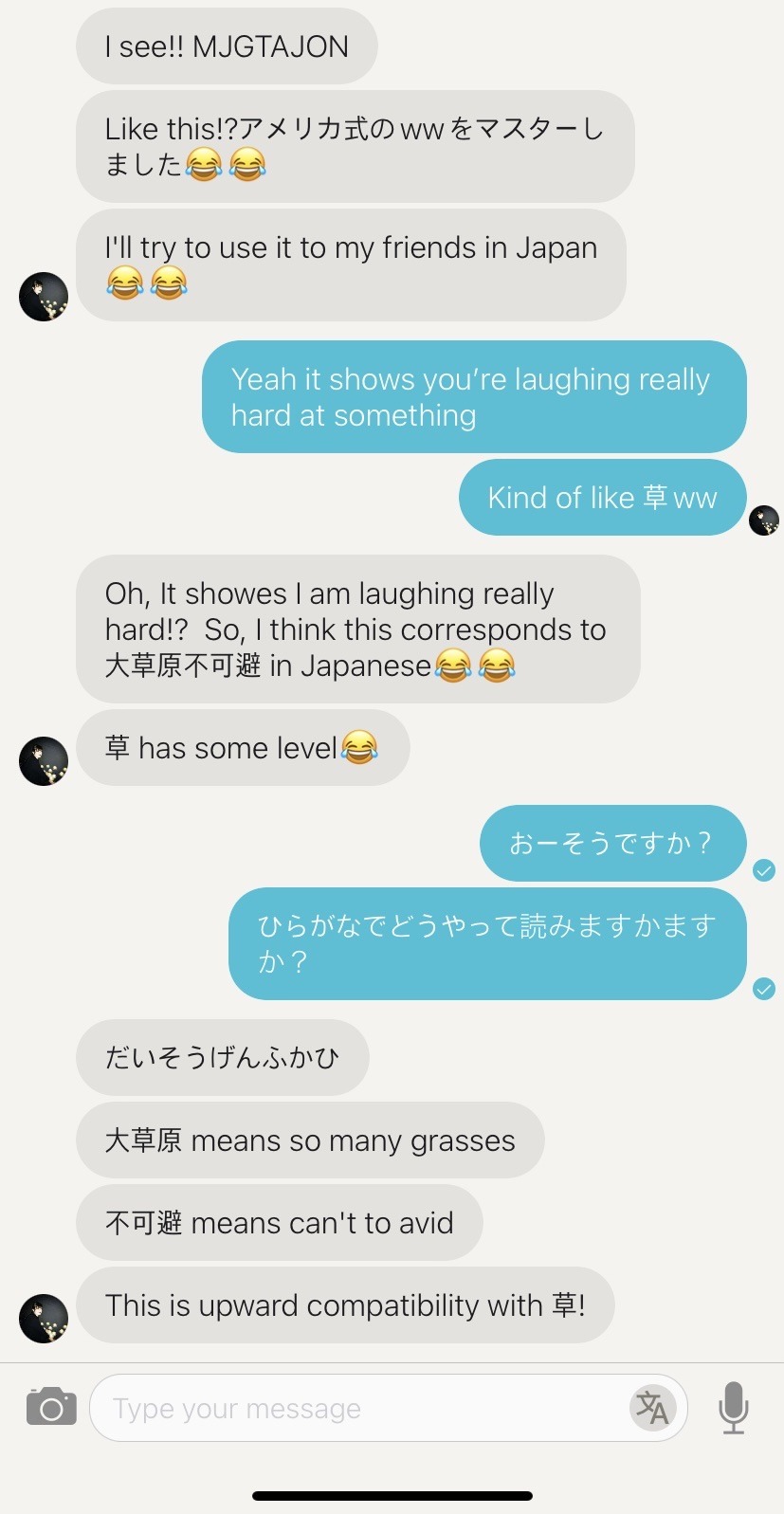Japanese - Blog Posts

「 EVA - 0 0 - PROTOTYPE 」

EVA-02

Hello kitty the Japanese version of Musti which is the Belgium version of Nijntje aka Miffy. And turns out her cat apearance is a costume? Nevertheless she's one cute Kitty cat #hellokitty #hellokittyfanart #hellokittyart #cat #cartoon #japanese #pink #ink #nijntje #miffy #art #drawing #sketchbook #collage #traditionalart #cute #sketch #lovely https://www.instagram.com/p/Bx138YairfC/?igshid=1b0ba1o1ht8lb
Do Japanese people say "itadakimasu" before eating someone's ass... Just wondering

🐀 Do not steal, repost, trace or edit 🐀




🍓Jun Togawa🍓🪱
I FRIGGIN NEED THIS
I've been learning Japanese for a while now and this is quite interesting to me thx.
大草原不可避 : Keyboard smashing in Japanese

I explained how keyboard smashing in English expresses laughing really hard and she taught me the Japanese equivalent in return!!
As some of you might know, in Japanese, “w” from the word “to laugh” 笑う 「わらう」 is basically like “lol” in Japanese so when there’s a bunch of “w”’s together it looks like this wwwwwwwwwwwwwwwwwwwwww
and it looks like a bunch of grass so one slang word to show something is funny is 草 「くさ」 which is the word/kanji for grass so you don’t have to type out a bunch of w’s.
So the step up from 草 is 大草原 「だいそうげん」 which means prairie since there’s a lot more grass.
And if something leaves you laughing so much that you can’t hold it back you could say 大草原不可避 「だいそうげんふかひ」 which basically means “inevitable prairie”.
The “inevitable part”, 不可避 「ふかひ」 in this phrase means laughter is inevitable and you can’t help but laugh.
Fake-tanuki soup or Fake tanuki-soup?
連濁(れんだく; en: rendaku)is a phonological rule in japanese that makes the first voiceless consonant of a word change into a voiced consonant when used in a compound word. For example, おり + かみ → おりがみ (ori + kami → origami) ("fold" + "paper" → "paperfolding") - the /k/ sound in かみ becomes a /g/ sound (which is the voiced version of a /k/ sound) by adding a voicing mark -> が.
What’s interesting about 連濁 is that native speakers can use it subconsciously as a sort of “order of operations” system for unfamiliar words, like PEMDAS or BIDMAS in maths. A classic example of this is the にせたぬきじる problem[1]. Native speakers can immediately and with confidence tell the difference in meaning between two compound words they have never heard before, despite the only difference being the voicing of a single consonant. Take the three words 偽 (にせ, meaning “fake” or “imitation”), たぬき (tanuki, the Japanese racoon dog), and 汁 (しる, meaning “soup” or “broth”). They can be combined into the following compound words: にせたぬきじる and にせだぬきじる (note the voicing mark, or dakuten, on the latter). Keep in mind, these two words do not exist in ordinary japanese - they’ve been created as part of a linguistics experiment.
You might think the meaning would be ambiguous in those compound words: is it (imitation tanuki)+soup or imitation+(tanuki soup)? Let’s imagine we’re referring to the former. First, we combine にせ+たぬき. There’s a rule that rendaku can’t occur if there’s already a voicing mark in the second component of the compound, but we’re safe here - たぬき has no voicing mark. Therefore, it becomes にせだぬき. Then, we combine にせだぬき+しる. Again, しる has no voicing mark in it, so we’re safe to add it in, and we get にせだぬきじる.
Conversely, let’s say we were referring to fake “tanuki-soup”. First we combine たぬき+しる. This combines safely to たぬきじる. Then we combine にせ+たぬきじる. But wait, the second component does already have a voicing mark, on じ! So we can’t add one to た. Therefore we end up with にせたぬきじる.
That’s a lot of thinking and linguistic hoops to jump through to make up 2 words, but here’s the thing: Japanese native speakers who have never heard these words before can instinctively deduce the difference in meaning with startling accuracy. They correctly determine the meaning of にせだぬきじる as “a broth made from imitation tanuki” and にせたぬきじる as “a fake version of a dish called ‘tanuki soup’”. Even more surprising is the research findings of Shigeto Kawahara, which show that children as young as 9 years old can consistently deduce the difference as well[2]. I think this shows how incredibly powerful the subconscious mind is at learning linguistic rules, and how bad the conscious mind is at learning them!
I love when characters in anime have super obvious names, it make learning japanese so easy!!
Denki means electricity, that's never leaving my brain. Hatsume means inventions; sure, that make sense. Toritsuka reita means being possessed, you can be sure I'm never gonna forget that word. More media should do that
Reblog and list in the tags which languages/dialects (besides your first or primary one(s)) you have songs in in your music library.

Tile - Contemporary Patio Inspiration for a large, modern, roof-extended side yard tile patio kitchen remodel
I study Japanese while I'm in high school and Chinese in college. you might see some difference from korean than the other two,
the best way to separate them if you learn some of the language and notice it's writing system.
the korean hangul way of writing is far so different from the other two. therefore it's easy to point it out first.
당신은 게이입니다
then Japanese... there's a hard problem, some of the Kanji is also used. but they also use hiragana so if you see them faster more.
君はゲイです
Lastly Mandarin.... as the oldest language from the three of them. a way of somewhat point it out is the same thing to see if the writing is in Japanese, but in reverse.
你是同性恋
in the end of the day. just hope someone wont write "I have a big dick" in all of those language in one sentence and being it send to you.
I don’t really understand getting mad at people for mixing up korean, chinese, and japanese
Like, look at them together
見る한국어中国死ね我要吃你マンコ형사我有大鸡巴
and tell me they don’t look similar lol
We learned the most beautiful phrase in Japanese class today...
私はズボンの中にハンバーガーがあります。
There’s no direct translation, but it can be interpreted as, “Our hearts are one, no matter what obstacles we face.”
I really love it because it shows the unity that love and friendship can have. Japanese is such a beautiful language.

japanese-revision:
Textbooks:
A Dictionary of Basic Japanese Grammar
A Dictionary of Intermediate Japanese Grammar
Read Real Japanese Fiction
GENKI: Integrated Elementary Japanese I and II [beginners]
An Integrated Approach to Intermediate Japanese
Tobira (Gateway to advanced Japanese)
TextFugu [an online textbook]
Heisig’s Remembering Kanji
Basic Kanji Book Vol.1
Kanji in Context
Shadowing: Let’s Speak Japanese! (Beginner to Intermediate Level)
Online Dictionaries:
ALC (I use this everyday) →Expression encyclopaedia
Goo dictionary
Weblio
WWWJDIC (with audio clips)
JWPce (downloadable dictionary for Windows)
JEDict (downloadable for Mac users)
Idiomatic Expressions
Zokugo-Dict (slang dictionary) [Japanese only]
Idioms dictionary [Japanese only]
Counters dictionary
Hovering dictionaries: →Rikaikun for Chrome →Rikaichan for Firefox →Floating Dictionary for Mac
Current Affairs dictionary
Tangorin
Imiwa? (a dictionary for the iPhone)
Tagaini Jisho (downloadable for Windows, Mac and Linux)
Nihongodict (also an app. for iPhone and Android phones)
For kanji.
Jisho (I use this for spelling kanji for if I can’t read it)
Yamasa (I use this for learning to write)
A Guide to Remembering Japanese Characters
Handwritten kanji search
Associative Kanji Learning (stroke orders)
WaniKani (reviewed and explained here)
Online reading:
Hukumusume Fairytales
竹取(Bamboo-Cutting) (vertical writing)
吉田秀幸の日記(Hideyuki Yoshida’s Diary) (recipes)
Chokochoko’s reading texts to help with JLPT
TED Talks (with Japanese subtitles and transcripts)
Learning through Films [Japanese subtitles/scripts]
Blue Sky Library (public domain books, explained here)
Manga.
Free online manga
Vomic (free online manga with voice actors)
Sound Effects (in manga, etc)
Improving your speaking:
Japanese pronunciation guide
Interactive Hiragana Pronounciation table
Topics for Language Exchanges.
Bubbly (a Twitter-like app where you can record yourself)
Audioboo (similar to Bubbly, but also a website)
My Language Exchange [to find a language partner]
Listening:
“Real World” Japanese
泣きたいときのクスリ 2007 - ‘08 (radio drama)
Writing practice:
Lang-8
Japan-Guide [for getting Japanese penpals]
原稿用紙の使い方 (How to write an essay with Japanese writing paper)
Shiritori (Japanese word-chain game)
iTalki [similar to Lang-8]
手書きブログ (Blogging by hand)
News:
NewsWeb Easy
NHK News (audio news with speed controls)
Mainichi Primary School student Newspaper
Podcasts:
JOQR (Cultural Broadcasting)
TBS Radio’s Junk
TOKYO FM
YouTube:
Afternoon Hirusagari
Jet Daisuke
バイリンガール英会話
Analog TV Forever (collections of adverts)
Real Japanese Studio
Japancast
Tofugu
Japanese sign language.
Heartful Power Hideo
Shuwa Island
TV:
Japanese subtitles for anime
KeyHole TV (to stream Japanese TV and radio)
風雲LIVE日本語(Feng Yun LIVE Japanese) (to stream TV)
映画で学ぶ実践英会話
Tumblr:
Kanji-a-Day
Holy crap Japanese
Nihongo ga Suki
Jumpstart Japanese
Nihongolog
Japanese Idioms
Nadine Nihongo
That Japan Addict
ChilliMuffin
A Little Help with Japanese
Japanese through Fandom
F-Yeah Native Japanese
J-Vocab of the Day
一文ずつ
Nihongobook
PuniPuni Japan
ぶらりめし [Japanese only]
Peaceful Chef [Japanese only]
Kumako365jp
Japanese Revision (my blog for intermediates)
Those studying in Japan.
Japanicking in Yamanashi (at Yamanashi University)
Samxuel (at Kyushu Sangyo)
Katy in Japan Town (at NUFS)
Chocotastie (at Seinan Gakuin)
Kim in Sapporo (at Hokkaido University)
Sunriseosunset / My Japan Travels (Yokohama National University)
Blogging:
Yaplog
Ameba
Learning websites:
JapaneseClass.jp
The Japanese Page
Tae Kim’s Guide to Learning Japanese
Erin’s Challenge (with listening and reading practice)
Maggie Sensei
Tofugu
All Japanese All The Time
Japanese Level Up
Other resources:
Lots of threads with a variety of resources for Japanese learning
JLPT Resources
Anki (flashcards for your computer, phone and online) →Yomichan (plug-in for Anki)
Quizlet (flashcards)
DJT and Okra’s pastebins (lots of resources and textbooks for download, etc)
Japanese.Livejournal (including tips on using IME)
Human Japanese (for PC and phones, excl. Linux)
I’ve added even more to the list since I first posted this and am continuing to add new things to it. So, I thought I’d re-post it. As always, if anyone has anything they would like to add, let me know!
/gives you smol cuties/ here is Hajime and my friend's OC Phoenix! I'm going to make some keychains with them for the first time



🥀just me enjoying Roxas mod
KH OC week 2024 - Day 6: Journal Appearance.

I would like to write a little about Hajime's design and why it is exactly the way you see it now.
The hairstyle has been there since the first design (I wrote about it), the reason why it is so: Hajime is directly connected to Vanitas, and Vanitas is a part of Ventus. However, the back of Hajime's head is shaved (the exact reason is still unknown in the plot, perhaps it was done by Even, perhaps it is his personal manifestation). Outside of the plot, I did this so that Hajime would have more of his own personality in his look despite how he is related to certain canon characters.

Directly about the face: Hajime has quite thick eyebrows and eyelashes, this is his own manifestation. The Hajime's gaze is heavy, the corners of his eyes are lowered. The eye color is jade, which has been with him since his very first design and is in fact the opposite color of the eyes of the Unversed. It is also noticeable from the look that Hajime has a darkened area from the eyebrows to the eyes: this is also natural for him. What was received later: dark bags under the eyes.
+ Hajime has an interesting feature: when he cries, his tears are partially colored black. This pigment is secreted by his body. This is also reminded by the darkened tips of his fingers and toes.

The Hajime's skin color is noticeably dark, which was inspired by Master Xehanort. This can be explained by the fact that Vanitas is connected to darkness.

When I drew his outfit I relied on the designs of the Unversed from Birth by Sleep. I took a little from each Unversed and came to the version that you can see now. (+ I think I'll use the last one for his appearance in KH III).
I really wanted to convey the feature of the Flood: pointed limbs, so Hajime has such pointed shoes and silver claws on his gloves. (+ I really love Aqua's shoes). The color of the outfit is inspired by the same Unversed.

@khoc-week
KH OC week 2024 - Day 5: Unique The Power Within.

Basic weapon
Hajime is a keyblade wielder.


For now I only have these sketches of his keyblade, still thinking about the design. Most likely it will change as story goes on. His keyblade will have a big plus in magic and a small plus in strength. This keyblade is long, the attack can be at a longer distance.
As you can see in the sketches, the keyblade refers to Hajime's real origin (Unversed). But for some reason I'm still not entirely sure about this decision. And yes, the chains also make sense in his design, I think it's not hard to guess why.
Magic
Hajime himself is more like a mage role in the party cause he inclined to magic. Even when attacking with a keyblade, the presence of magic is often noticeable in normal attacks.
In game, Hajime would always have a higher MP bar than HP bar. Therefore, Hajime is more focused on preventing damage and is comfortable for him keeping the enemy at a distance.
Easy to use + high resistance: Blizzard, Thunder, Gravity.



Difficult to use + low resistance: Fire, Aero.
Later, Hajime will show himself as an excellent tactician who can use almost anything around him to his advantage, including the help and strength of his party members. However, Hajime is still more like a lone wolf type of a fighter, so he is bad at supporting party members, but he is already useful in improvement the outcome of the battle in favor of his party through his tactics.

@khoc-week


that's how popee the performer zine i worked on together with other amazing artists look in my copy of it


cover artwork for popee the performer zine

my artwork for popee the performer zine 2024 (contain trigger warnings)









